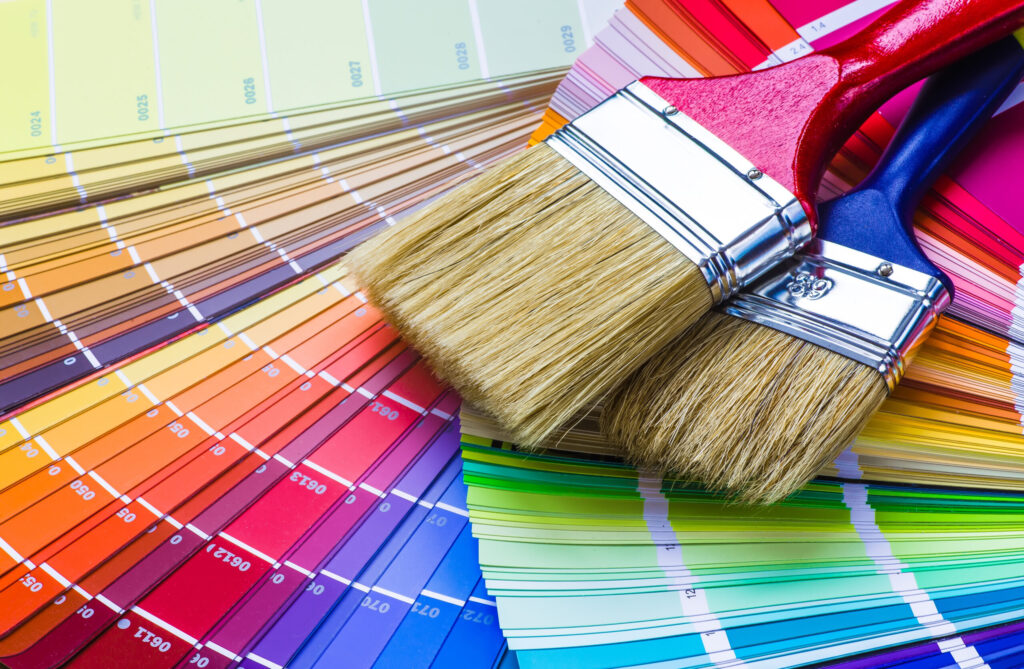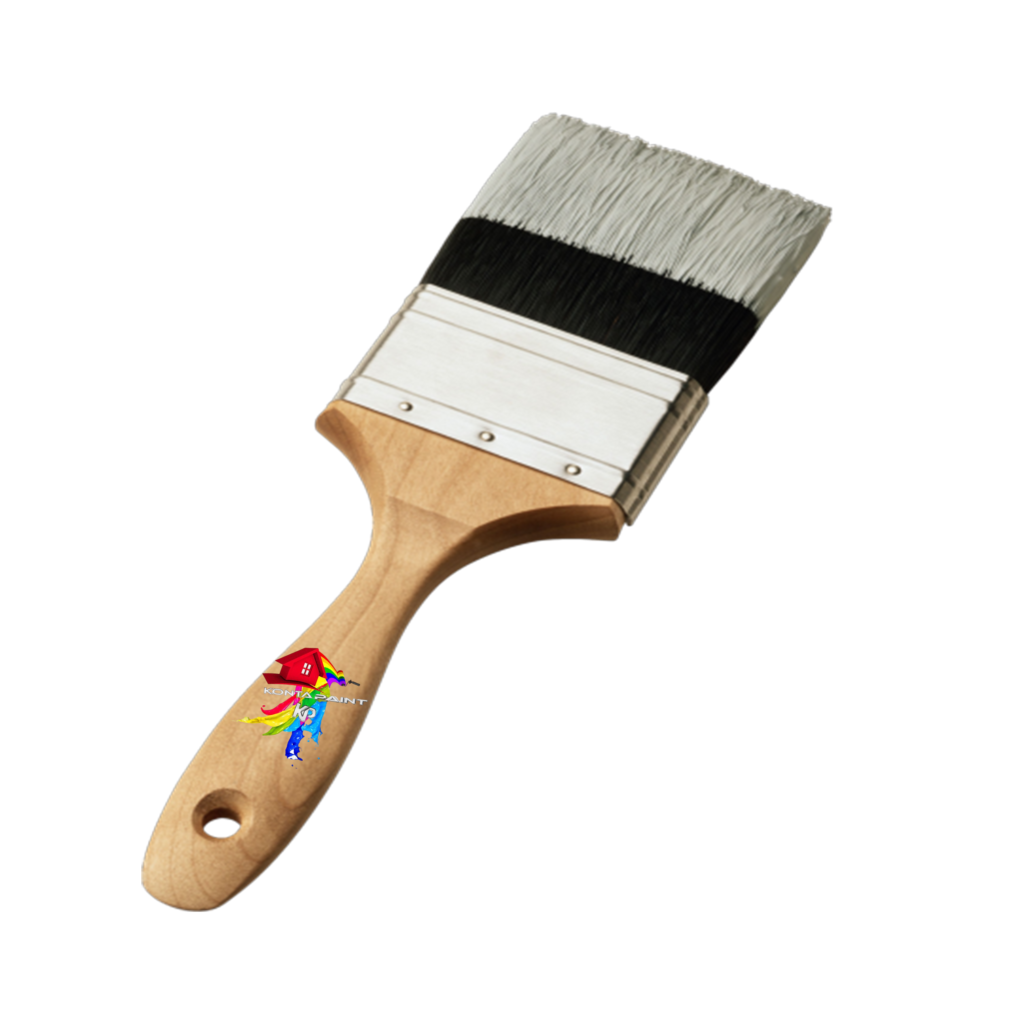
In the home it is always a good idea to decide on the actual finish and texture you require before selecting the application process.
Certain Faux Finishes will need specific brushes, rollers or textured applicators. Other plain smooth colors will only require the basic applicators such as a good quality brush, roller or paint pad.
Try to steer away from paint finishes that require specialized equipment such as air spraying, which will require contractors to apply, and may result in the room being un occupied for up to a week as airborne mist can linger in the atmosphere of your home for a long time.
There are many modern techniques of application that are available today that allow for remarkable finishes to be quite easily achieved, without the use of specialized applicators or equipment.
Visit our Special Effects section to view how many creative paint effects can be instantly achieved using simple techniques in combination with our vast array of Special Effect paint finishes.
BRUSH SELECTION
The most prestigious quality of brushes is made of hog bristles. These hairs are split into several fine strands that enable a perfect finish to be achieved.
When using medium quality brushes, that are constituted of animal hair, or vegetable fibers a reasonable finish can be achieved, although the brushes have a shorter life span.
Nylon brushes are commonly available and whilst are relatively inexpensive, tend to be non absorbent and thus allowing the paint to simply drip off the brush, holding less volume, despite their durability.
Prepare for the job at hand, think about the size of brush you will require, and what area of the home you will be painting can dictate the material of the brush you will require, the size and the length of time needed to complete the job. It is generally a good idea to have several brush sizes at hand before you commence any painting job, as various sizes will be used for different corners and edges of a room.
BRUSH & ROLLER
Brushing is the oldest, and a versatile method of application under unlimited variable conditions and situations. It is still the best method to paint large complex objects. Brushing helps the paint penetrate and reduce wastage. It is mainly used for decorative and maintenance application.
Choice of brush
Best quality brushes are made up of hog bristles. These bristles taper from the roof towards the tip where each is split into two, for finer strands known as flag, which deliver slick finish.
A proportion of animal hair or vegetable fibres are used in cheaper variants. Brushes made of nylon bristles are also available. These are superior than pure bristles in their resistance to wear, but are smooth and non-absorbent. Hence, they carry less paint and have a tendency to overspill from the brush.
Always select a brush of suitable size, for the work at hand. Using a small brush on a large area makes it difficult to apply an even coating and slows down rate of working; while using a large brush on a narrow area makes accurate “cutting in” impossible.
Use and maintenance of brushes
Bristles in new brushes hold dust and must be washed out before using for finish work. Soap water can be used for washing out the new brushes. A paint brush works best when it is ‘broken in’ i.e. the tip of the bristles are levelled. A brush must be ‘washed in’ in order to distribute the paint throughout the thickness of the brush. The brush is dipped in paint and rubbed against the sides of the kettle. After painting is over, brush back the excess paint into the container and scrap clean it with a blunt putty knife. Rub it on a suitable surface and rinse out in a thinner and ‘spin’ dry. Wash it thoroughly with soap water and leave it for drying.
Brushing technique
- Start with smaller areas for even distribution of paint without loss of time. Otherwise, brush marks are inevitable.
- The pressure of the brush must be equal for all strokes so that the paint easily penetrates into the surface.
- To ensure the levelling and elimination of brush marks, ‘laying off’ should be done with very less pressure.
Paints suitable for brushing
Air drying type, based on long/medium oil length alkyds, emulsion are ideal for brush application. Quick drying type paints based on medium to short oil length alkyd and fast evaporating solvent like Xylene are not suitable.
When preparing to paint your home, it is important to ensure all your applicators are clean, free from dust and grease, and brushes have no loose bristles.
Wash your brush and roller applicators in mild warm soapy water before use. Allow to dry before use.
Brushes should be washed in, which means the paint must be evenly distributed throughout all the length of the brush bristles. The brush can be dipped into the paint and rubbed against the edge of the paint can.
After the painting job is complete, remove the excess paint back into the paint can, and scrape the brush clean before washing in warm soapy water.
TECHNIQUES
At all times, select the appropriate size of brush for the area to be painted. Larger areas require a bigger brush to avoid brushmarks that may occur if painting larger areas with a small brush.
The pressure of the brush must be equal with all strokes in order for the paint to easily and evenly be distributed over the surface.
Use medium to light brush strokes to avoid heavy brushing, which may result in brush strokes being visible and uneven paint layers.
PAINTS FOR BRUSHING
Generally, the paints that are most suitable for brushing are long/medium oil-based paints, emulsions/alkyds and all AIR-DRYING PAINTS.
FAUX FINISHES & HAND ROLLING
In today’s Special Effect paints are quite common. With these paints there are often special rolling textile, or applicators that provide the special effect.
These effects are very decorative and are used to decorate selected areas of a room, to contrast with the opposite wall or to decorate an entire wall area creating a dynamic effect, to highlight a room.
CONTAINERS
When painting large areas, it is more suitable to use a clean bucket, rather than a tray. Most paint buckets come with a plastic grid within the bucket which the roller can be rolled onto, to remove excees paint and evenly distribute the paint onto the roller. For best results use criss cross strokes to distribute the paint evenly onto the roller.
Roller applications are not as rapid as Spraying techniques, they are faster than all brush or hand rolling applications. In addition, most people with little painting experience can quickly learn how to create a good finish using the roller technique.
When a super-fast paint application is required, then the use of a spray system is generally what is required. Spraying paints can be a detailed system, and the necessary precautions must be put into place before commencing a spray-painting job.
Adequate ventilation/gloves/special respirator for airborne solvent or water based paints must be worn at all times, eye goggles,and/or face mask.
Paints that are based on short oil alkyds and other formulas that are fast evaporating solvents like Xylene and White spirits are best used in the spray paint application.
The thinned paint is passed through a stream of air, and a perfect balance of air and paint is necessary for the atomization and successfull spray finish.
Ensure the spray gun and all its parts are clean and dirt/grease free. All filters should be regularly checked and cleaned with the appropriate solvent cleaners.










Roller application
Hand rolling
At present, hand rolling is done mainly for decorative and maintenance paintings. Roller Coating application is most effective on broad plain surfaces. The covering material for the roller can be plastic sponge. When equipped with a long handle extension, you can use the roller for floor painting and places that are otherwise inaccessible.
Techniques
For larger areas it is more convenient to work from a bucket than a tray. A perforated grid is placed inside the bucket, the roller is dipped into the paint and then rolled over the grid to remove surplus material and distribute evenly. In the tray, a reservoir at one end holds the paint. After charging the roller, it is rolled out on the platform of the tray. To use, roll is roller over the surface in criss-cross strokes, working the material out evenly. Paints normally used for brushing can be hand-rolled.
Advantages
Although not as quick as spraying, it is usually quicker than brush application, especially on rough surfaces. Another advantage is that it enables the semi-skilled operator to obtain a reasonable standard of finish and hence, is likely to be popular with amateur painters. Roller application on narrow or broken surfaces does not show any special advantage over brushing.


Machine rolling
Roller coating application is used exclusively for coating metal containers such as tins, drums, kegs and barrels.
The coating material is fed on the rubber roller through two smaller feed rollers which are of precision ground iron or steel, and which are also adjustable for pressure in order to regulate the film thickness of the coating. The sheets pass between rollers, rubber covered roller and a metal backing roller. After coating, the sheets pass through conveyor belts in the ovens and are stewed.
Paints suitable for roller coating must have
- Excellent adhesion and flexibility
- Complete opacity
- Perfect flow and application characteristics
- Adequate chemical resistance for end use
- A hard mar-proof film formation quality
- Adequate intercoat adhesion between coats
The main features of this process are high product rates, minimum losses, controlled film weight and thickness and economy.
INDUSTRIAL MACHINE ROLLING
Industrial contractors tend to use roller coating for painting metal and tin drums, kegs and circular containers. These specific types of coatings are fed through special rubber rollers, which regulate the paint onto the flat metal sheeting, which are then passed through ovens and are baked onto the sheet surface.
For best results when using roller coating techniques, the paint properties should have strong chemical resistance, high opacity, good flow out properties, durable adhesion to the primer or base metal sheeting.


Spray application
Paint suitable for spraying
Paints are normally based on short oil alkyds and compositions based on fast evaporating solvents like Xylene and NC Lacquer.
Conventional spraying
This method works on the principle of jet of fluid paint subjected to a stream of air. The correct balance between air and paint is essential for atomization and hence, successful spraying. The system required for spray painting consists essentially of a source of compressed air, filter for removing dirt, water and oil, a container for the paint and a spray gun.

